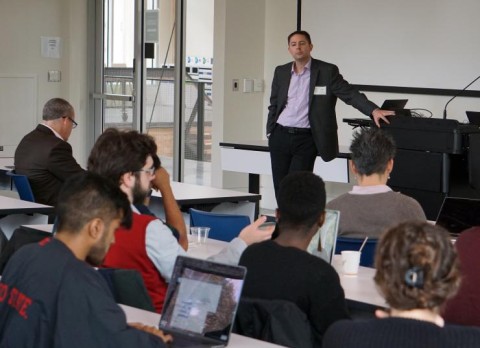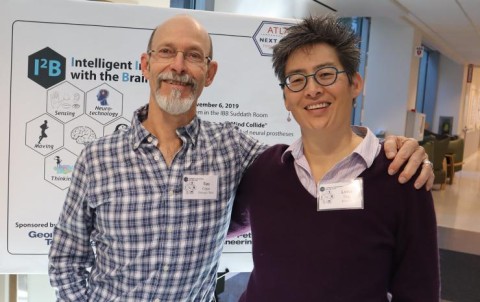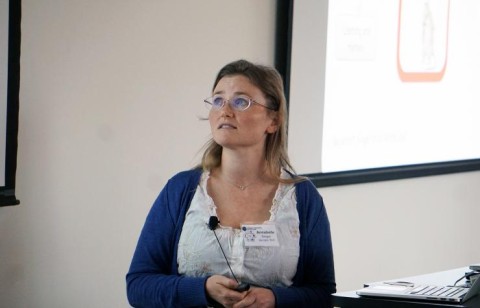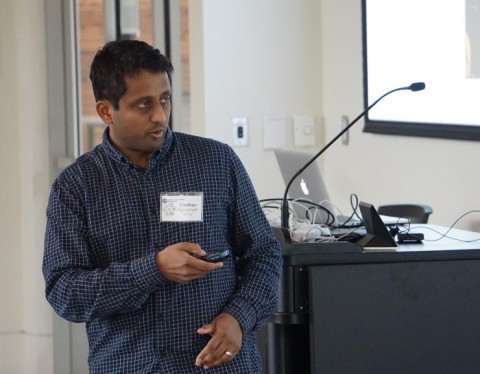





There is a growing national community of researchers taking our understanding of brain function to the next level, and some of them recently gathered at the Georgia Institute of Technology to share their vision at the Intelligent Interactions with the Brain (I2B) Workshop.
Investigators and students from Georgia Tech, Emory University, Carnegie Mellon, the University of Pittsburgh, Rice University, and Florida International University came together to explore research in areas such as computational engineering, computational neuroscience, and the clinical use of emerging neurotechnologies.
“With this great community of faculty and students, we have unique opportunities to do cutting-edge research using sophisticated computational methods to understand neural activity and their relationship to behaviors in health and disease,” said Lena Ting, professor in the Wallace H. Coulter Department of Biomedical Engineering at Tech and Emory, and a researcher in the Petit Institute for Bioengineering and Bioscience.
“We need new theories and technologies to understand brain as a dynamic and adaptive system that changes moment-by-moment, and in individual specific ways,” said Ting, who co-directed the event with fellow Coulter Department/Petit Institute investigators, Chris Rozell and Garrett Stanley. “Ultimately such research can lead to smart neural technologies that adapt and change with us and which could treat neurological and psychiatric disorders.”
The workshop evolved over two days (Nov. 6-7), starting at the Petit Institute, and concluding at the new Kendeda Building, the most sustainable building in the Southeast, one designed to generate more on-site electricity than it uses. An event like I2B injected its own kind of energy, covering a range of issues, including a few that aren’t typically part of neurotech development, including neuroethics (the impact of technologies on the human experience), “and the challenges of getting the technologies into humans in the first place,” Ting said. “We wanted to have public discussion that could seed these ideas in the next generation of students who will be advancing these technologies so they could think about these challenges at the beginning of their research careers.”
As a field, neuro research is exploding, according to Stanley, making interfaces between technology and the brain and nervous system inevitable – and making the resulting technical, educational, and ethical challenges also inevitable.
“As neurotechnology starts to move from the lab to the clinic and industry, there are a lot of issues for our community to tackle,” Stanley said. “And I think we brought in a good team of people from different areas within neuro research to talk about these high-level issues, people who can help us move forward.”
The research enterprise is on the cusp of understanding the brain well enough now to consider what could be a robust commercial venture around neurotechnologies, including investigators engaged in basic research. “We’re certainly motivated by the idea that basic discoveries can have an impact on people down the road,” said Rozell, who is also a professor in Tech’s School of Electrical and Computer Engineering. And we’ve got some powerful things to think about as we shape the future of the field.”
As the leadership team looks ahead to the next I2B workshop (there will be another, Stanley said), they remain committed to an inclusive, collaborative approach within the current six-university consortium, and beyond.
“Neural engineering has to be a highly collaborative endeavor to be successful, reflecting the many perspectives and values of society,” said Ting, reflecting on her takeaways from the November workshop.
The effort she envisions would include not only the usual participants – research engineers, scientists, and clinicians – but also government, industry, patients, ethicists, the general public, “even artists,” Ting said. “That’s a tall order, but we are hoping to influence how we educate students and go about our research and be more inclusive of diverse perspectives and approaches.”
Jerry Grillo
Communications Officer II
Parker H. Petit Institute for
Bioengineering and Bioscience
